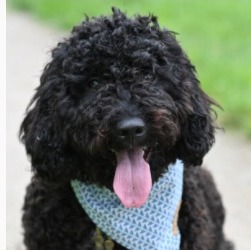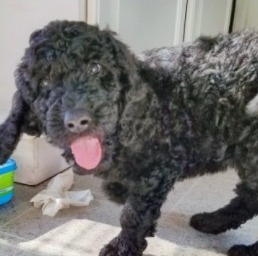
Before scrolling down this black Labradoodle guide, check out these other similar content: Labradoodle Dog Breed Guide and Blonde Labradoodle Guide.
What is a Black Labradoodle?

Depending on whether a Labradoodle is an F1 or F2 generation, its parents will be either a Labrador and a Poodle or a Labradoodle and a Poodle. This means that a black Labradoodle can have different coat types depending on its parents, but the color will always be black.
Related: Red Labradoodle Coat Guide and Australian Labradoodle Guide.
History of the Breed

This was done out of the need to produce a guide dog that would not trigger an allergic reaction. The result was a few Labradoodle puppies, one of which had fur and saliva that proved not to aggravate the client’s allergies. It was this litter of Labradoodles that sparked the beginning of the Labradoodle craze.
Color and Coat Type

While most people think of Labradoodles as the offspring of a Labrador and a standard Poodle, this is not often the case. Labradoodles are categorized into generations based on their parentage. For example, puppies born from a Labrador and a Poodle are considered an F1 generation.
The most common type of Labradoodle, however, is what is known as the F1B generation. F1B generation is a Labradoodle whose parents are a Standard Poodle and an F1 generation Labradoodle. Because F1B Labradoodles have a higher percentage of Poodle DNA than their F1 counterparts, their coats will favor the Standard Poodle, which is more allergy-friendly than that of the labrador.
There are also F2 generations, Labradoodles bred from two F1 generation dogs, or an F1 dog bred with a second-generation or higher dog. Multi-generation Labradoodles are defined as third-generation or higher.
It is important to consider which generation a Labradoodle puppy belongs to determine what type of coat it is likely to have as an adult. The more Poodle DNA a Labradoodle has, the more likely that their coat will be hypo-allergenic. Because of this, F1B generation Labradoodles are the most popular, as many people enjoy the low-shedding and allergy-friendly coats of these dogs.
Fading

Fading can occur for several reasons, including:
- Dilute Gene: The “D” or Melanophilin gene, known as the dilute gene, will cause black Labradoodles to appear a light gray color. This is because the dilute gene disperses the coat’s shade on the hair shafts, resulting in a lighter hue. The dilute gene is recessive, meaning a dog must inherit two recessive “dd” genes from its parents. Since a dog can carry this gene without showing any symptoms, it is hard to know if this trait will be passed on to puppies.
- Kemp Hair: Kemp-hairs are coarse white hairs that usually appear in adult Labradoodles. Appearing most often around a dog’s eyes and down their backs, these hairs can break up the solid color of a black Labradoodle.
- Health: Some health issues, such as hypothyroidism and liver and kidney problems, can cause a black Labradoodle’s coat to lighten in color. It is important to consult a veterinarian about any sudden changes to your dog’s appearance, as it could be caused by illness.
Temperament
In addition to coat type, the genetics of black Labradoodles will also, in part, determine their temperament. Both the Labrador Retriever and the standard Poodle have friendly, even-tempered dispositions. However, the Poodle is a bit more standoffish than the Labrador and tends to be more independent. This is why Wally Conron chose to create the Labradoodle instead of simply training a standard Poodle to be a guide dog.
If you are looking for a black Labradoodle to work as a service dog, it is a good idea to consider selecting an F1 generation Labradoodle, as these dogs will have an even amount of DNA from both the Labrador Retriever and the Standard Poodle. Compared to the other color varieties, there is nothing about the black Labradoodle’s temperament that sets them apart.
After all, coat color does not affect a dog’s temperament. Instead, that is determined by the genetic makeup of the dog. While there is no guarantee of what a black Labradoodle puppy’s temperament will be, carefully considering its genetics and parentage can give you insight into its potential as a service dog or friendly companion.
Grooming
All Labradoodles require a fair amount of grooming, and black Labradoodles are no exception. Depending on the type of coat, grooming can range from once a week to once a day. Labradoodles that favor the Poodle’s curly coat, for example, will require daily grooming to prevent mats. At the same time, those with the short, flat coat of the Labrador can be groomed every week to minimize shedding.
Related: Labradoodle Grooming Guide.
Exercise

Recommendations: Best Dog Playpen for Hardwood Floors.
Size
Black Labradoodles are available in three sizes: Standard, Medium, and Miniature. Standard Labradoodles typically weigh between 55 to 65 pounds, while Medium doodles weigh around 30 to 40 pounds. The miniature is the smallest size available, weighing no more than 25 pounds. With three different sizes, it is easy to find a black Labradoodle that fits your lifestyle.
Related: Labradoodle Size Guide.
Frequently Asked Questions
Whether you’re just trying to learn more about the breed or you’re considering bringing a black Labradoodle into your family. you probably have questions! Here are some of the most commonly asked questions we’ve received from our readers.
Are black Labradoodles rare?
Nope. In fact, you may be surprised to learn that black is the most common Labradoodle color. The rarest color for a Labradoodle to exhibit is red.
How much does the black Labradoodle cost?
If you’re considering adding a black Labradoodle to your family, you can expect to pay in the thousands if you purchase a puppy from a breeder. Remember, though, that there are thousands of deserving dogs – including Labradoodles – in shelters across the country. These dogs “sell” for an adoption fee that’s a fraction of the purchase price for a puppy.
Visit local shelters to find a black Labradoodle to bring home, and you’ll gain a dog that’s been spayed or neutered, vet-checked, and usually even microchipped. In this way, too, you’ll be opening up a space in that same shelter for another dog that deserves a new home.
Are Labradoodles a difficult breed?
Labradoodles are very smart dogs, but they can be difficult to train, in part, due to their high energy levels. Begin to train your dog from an early age, and teach your kids how to properly handle your dog.
In addition to training your dog, you’ll want to make sure you have the resources and time to have your pup groomed. When he’s not brushed on a regular basis, your pup’s fur can become matted and tangled.
Talk to your vet about the proper diet and exercise for your dog to keep him in the best health possible.
Conclusion For “Black Labradoodle Information, Facts, Images”

For more Labradoodle guides, you can check out:
- Toy Labradoodle Puppies For Sale
- Mini Labradoodle vs. Mini Goldendoodle
- When Do Labradoodles Stop Growing?
Learn more about the Labradoodle by watching “Labradoodle Dogs 101” from Animal Facts down below:

Andy is a full-time animal rescuer and owner of a toy doodle. When he’s not saving dogs, Andy is one of our core writers and editors. He has been writing about dogs for over a decade. Andy joined our team because he believes that words are powerful tools that can change a dog’s life for the better.
Why Trust We Love Doodles?
At We Love Doodles, we’re a team of writers, veterinarians, and puppy trainers that love dogs. Our team of qualified experts researches and provides reliable information on a wide range of dog topics. Our reviews are based on customer feedback, hands-on testing, and in-depth analysis. We are fully transparent and honest to our community of dog owners and future owners.


